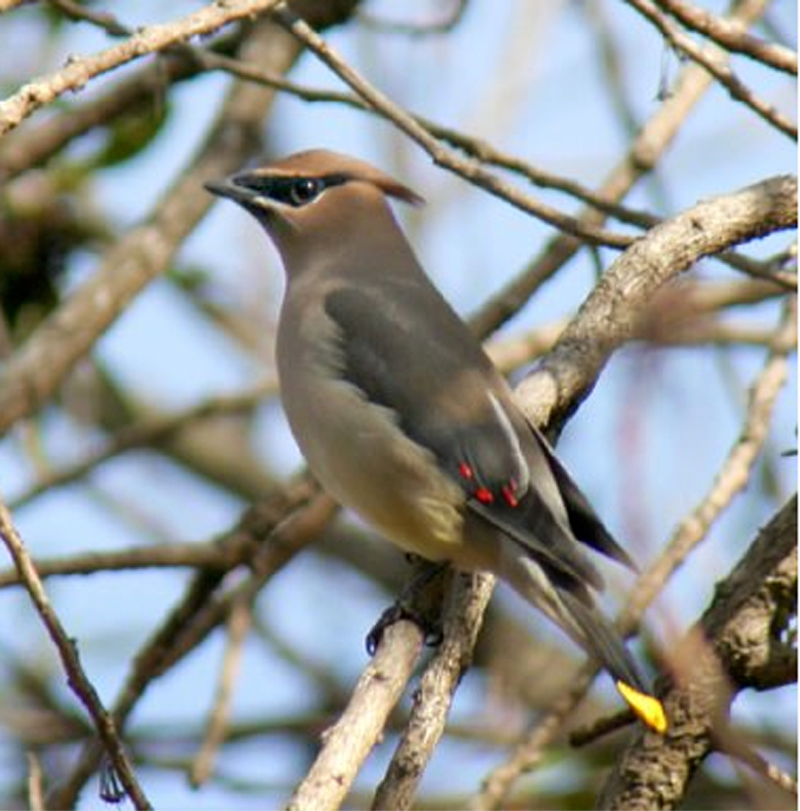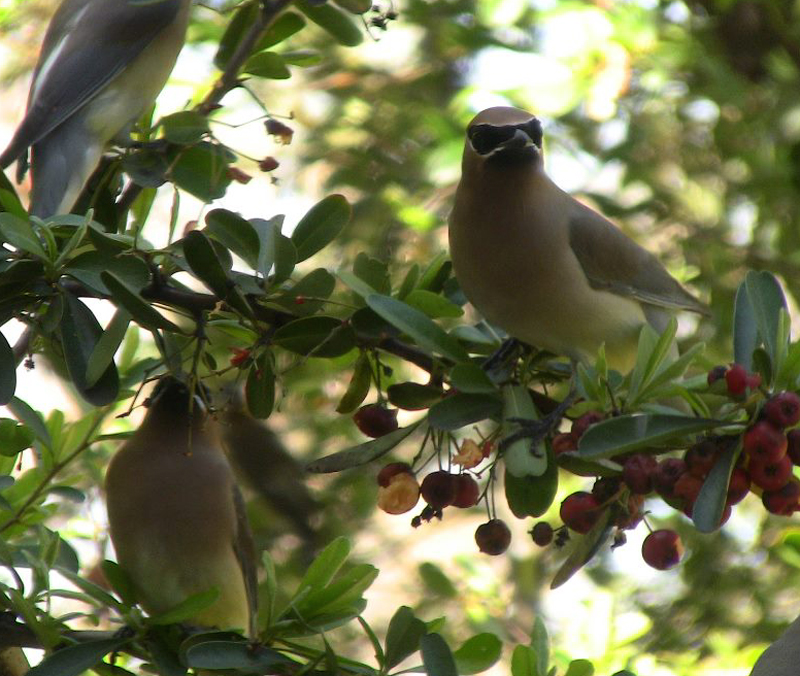 The cedar waxwing is the only bird I know that gets drunk.
The cedar waxwing is the only bird I know that gets drunk.
How does this happen? About 85 to 90 percent of their diet consists of fruits and berries. They descend on the tree or bush and really gorge themselves until they are all round-bellied and satisfied.
They eat voraciously, sometimes feeding on overripe fruits in such a large quantities that they will actually become intoxicated and unable to fly.
Because they have a very fast metabolism, this drunken condition does not last too long – and that’s good, because for birds, like humans, it is a vulnerable position to be in.
To be completely fair, there was another theory about the drunkenness of the cedar waxwing. A study was done to see if it was the berries accumulating in the bird’s crop that would push against the carotid arteries so they would become impaired or pass out. No such luck. The results of the study showed they were totally drunk. I guess the nicer way would be to say they were “vulnerable to alcohol intoxication.”
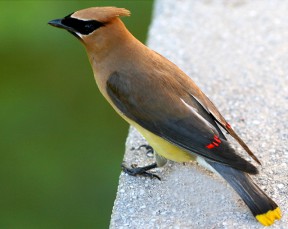 In Southern California, cedar waxwings are winter visitors. They are around from the fall to sometime in late spring. They are opportunistic feeders; they look for food and will settle for a few days where they find a good supply. They will strip trees or bushes of every possible berry, and when the food supplies decrease, they move on to look for another place where they can find the ripe berries they enjoy.
In Southern California, cedar waxwings are winter visitors. They are around from the fall to sometime in late spring. They are opportunistic feeders; they look for food and will settle for a few days where they find a good supply. They will strip trees or bushes of every possible berry, and when the food supplies decrease, they move on to look for another place where they can find the ripe berries they enjoy.
In our area, I have often seen them eating toyon and pyracantha (firethorn). Those berries do not get too sweet, so I am still waiting to see my first drunken waxwing.
They eat all kinds of berries, cherries, grapes, blackberries in the summer – so it must happen somewhere, just not in our area. They find plenty of food in the many ornamental bushes that adorn our gardens and parks, and they also eat insects.
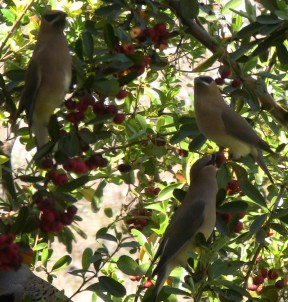 Cedar waxwings play an interesting role in plant propagation. They eat many berries, and while the fruit is digested, the seeds are not. They spread the seeds each time they defecate.
Cedar waxwings play an interesting role in plant propagation. They eat many berries, and while the fruit is digested, the seeds are not. They spread the seeds each time they defecate.
That is not always the case with all birds. The seed-eating birds (smaller birds with smaller beaks) eat seeds but digest the seeds and do not help with plant propagation. Cedar waxwings help in plant reproduction. The kind of small insects they eat are usually pests on berry bushes, so their eating pattern is beneficial all around.
What happens if you eat sweet fruits all day? You get thirsty. This is why waxwings need a constant supply of fresh water. I have seen flocks of 20 descend on my bird bath, splashing and rolling in the water with sheer joy and abandon.
Cedar waxwings are social birds, and when you observe them, what takes your breath away is the way the flock flies. How can I describe this? Like a scarf flying in the wind? They all stay together, with frequent changes of direction, but all of the birds fly in unison in a tight formation, somewhat like the flight of the starlings.
When they attack a tree to pluck the berries, they also act as a group, gliding to the specific destination, all in harmony. They land on the top branches and check the area. A few birds go down to check the berries; then they take turns eating.
The same behavior is observed if the water supply is small. They take turns until all have a chance to drink.
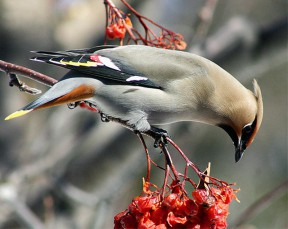 However, I have also observed that if the food supply and water supply are safe and plentiful, they fly upside-down and gorge themselves with an observable joyfulness, even a touch of craziness, that I have not seen in many birds.
However, I have also observed that if the food supply and water supply are safe and plentiful, they fly upside-down and gorge themselves with an observable joyfulness, even a touch of craziness, that I have not seen in many birds.
When other birds, even if they are part of a flock, arrive to the spot where they are going to feed, they are totally involved in finding food for themselves. They are in a flock for protection and because it’s easier to find food in a group, but when feeding time arrives, they are in competition to find the most food in the fastest and safest way possible.
It is different for the cedar waxwings because they are social feeders. I have not seen this, but I have read that they can help each other with food supply. One bird passes a berry to the next bird, which passes it down the line until the last bird in line eats it, and they repeat the process until everyone has its share.
I mentioned earlier that cedar waxwings are winter visitors in our area, so now is still a good time to observe their behavior. They do not nest here, but their mating ritual is so delightful, I have to share that with you.
Usually the male brings an offering of food (berry, insect or flower petal). How lovely is that? The female accepts the gift, does a little hop left and right (acting coy?) and gives it back to the male, which insists she have it, and the gift passes from beak to beak a few times until the shy female accepts the gift and eats it. This is followed by rubbing their beaks together … very sweet. The rest is history.
Why are they called cedar waxwings? Do you remember that important letters were sealed with warm, red wax in the past? These gorgeous birds have a tiny red spot on the secondary flight feather, and it looks like a drop of the red wax, so it is believed this is where the name came from.
They are truly beautiful and interesting birds, and I hope you will have a chance to observe them at least once. Stop if you see a flock of birds acting in unison in the sky. It might be the cedar waxwings in action.
Evelyne Vandersande has been a docent at Placerita Canyon Nature Center for 27 years. She lives in Newhall.
Cedar Waxwings: Party Animals? | Commentary by Evelyne Vandersande
